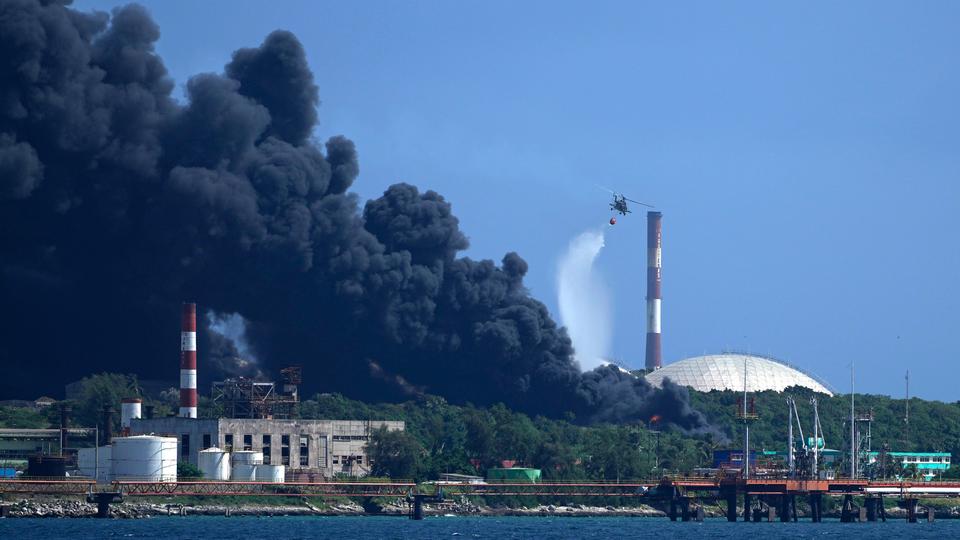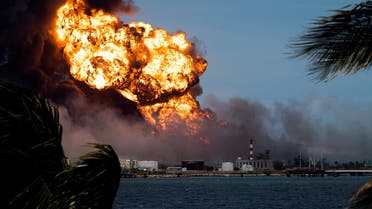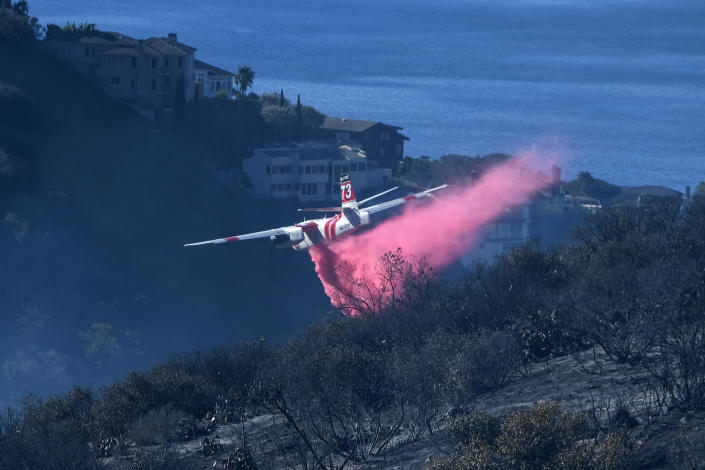Mike Kelly, NorthJersey.com
Updated Fri, July 14, 2023
NEWARK, N.J. — Firefighters are helpers by nature. It prompts them to run into danger. It’s also the glue that holds them together in tough times.
And so, on a hot, windy Thursday in Newark, New Jersey, hundreds of firefighters — some traveling from as far away as California — gathered to help one another get through the first of two long goodbyes to two Newark firefighters who perished last week after they were trapped aboard a burning ship loaded with used cars bound for Africa.
“This is what it’s all about,” said Tim McGovern, a retired Newark battalion chief who drove from Toms River to pay tribute to firefighter Augusto “Augie” Acabou, 45, who was overcome by smoke along with his colleague, firefighter Wayne “Bear” Brooks Jr., while battling flames aboard the Grande Costa D'Avorio, a 692-foot cargo ship, on July 5.
“When something like that happens, you show up,” McGovern said. “It’s part of the job.”
Augusto’s nearly three-hour funeral at Newark’s Cathedral Basilica of the Sacred Heart on Thursday morning ended only a few hours before a wake for Brooks, whose funeral took place at the same church on Friday morning.
Timeline: Chief breaks down department's response to fatal Newark ship fire
Profound anguish
For firefighters, the loss of just one of their breed in the line of duty often sets off deep emotions about the ever-present dangers of the job that requires them to run into a fire instead of from it. But the loss of two firefighters in Newark seemed to set off especially widespread sorrow.
The anguish was even more profound because Acabou, 45, a 10-year veteran of the Newark Fire Department, and Brooks, 49, who served 16 years, were not rescuing people. They died trying to extinguish a blaze that broke out amid nearly 1,200 cars parked tightly together aboard a 12-story cargo ship that is nearly as long as two football fields.

Firefighter Augusto Acabou's Funeral at the Cathedral Basilica of the Sacred Heart in Newark on Thursday, July 13, 2023.
“That’s what brings us together,” said Lt. Joseph Hoyle Sr., a 31-year veteran of the Englewood, New Jersey, fire department. “We understand our profession, and we understand the extreme risks. But to lose two firefighters to a car fire is especially difficult to live with.”
Hoyle said he hopes that the questions raised about the ship fire would result in some changes in how to battle shipboard fires, just as criticism of the firefighters’ response to a blaze in a truss roof at a car dealership in Hackensack, New Jersey, in July 1988 resulted in new firefighting standards across America.
One recommendation that Hoyle said he and other fire fighters would wholeheartedly support would be the establishment of specially trained fire brigades at America’s shipping ports.
“This will, without a doubt, cause a renewed focus on having a fire service especially at our ports,” Hoyle said of the fire.
In the wake of the deaths of Acabou and Brooks, firefighters have voiced criticism of Newark’s fire department for what they described as insufficient training and equipment to fight ship fires. Some of Newark's fire engines are staffed by only one officer and just two fire fighters. The optimum staffing of fire engines is one officer and four or five fire fighters. But many municipalities cuts budgets by trimming staffing levels.
In a larger sense, firefighters from across the region also questioned why nozzles on the cargo ship’s firefighting system were only one inch wide while the firefighters arrived with hoses with nozzles that were 2.5 inches wide.

Firefighter Augusto Acabou's funeral at the Cathedral Basilica of the Sacred Heart in Newark on Thursday, July 13, 2023.
The criticism also raised concerns about whether the Port Authority of New York and New Jersey should establish its own specially trained fire department for its 272-acre docking facility in Newark, the nation’s third-largest port. For decades, the Port Authority, which has specially trained fire fighting teams at its airports, has relied on Newark’s fire department, which is trained mainly to fight fires in home and offices, to respond to fires at its shipping ports.
Before Acabou’s funeral began, Sean DeCrane, director of health and safety operational services for the International Association of Firefighters, the nation’s largest firefighting union, said federal safety officials planned to examine the Newark port fire with an eye toward improving firefighting techniques. But DeCrane said in an interview with NorthJersey.com and The Record outside the cathedral basilica that the federal study could not begin until Newark’s fire department officially requested it.
On Thursday, Newark fire officials were unavailable for comment on this issue.
Mike Kelly: As Newark firefighters are laid to rest, these are the questions we must answer
More: Newark firefighters union blasts 'neglect' by city in wake of two deaths
A final farewell
Acabou’s funeral was a mix of tradition and heartfelt family memories.
In addition to English, scripture readings were recited in Acabou’s native language, Portuguese.
A large American flag hung from ladders between two firetrucks as Acabou’s coffin was brought to the cathedral basilica in an antique fire engine. A pipe band played the Irish funeral tune “Going Home” — a tradition at many fire department funerals across America. As a farewell, three fire chiefs rang a bell and a Newark fire dispatcher sent a final radio message to city fire fighters that Acabou had answered his last call.
Police on horses stood by. Hundreds of firefighters, clad in blue uniforms and white gloves, saluted. Color guards from fire brigades from across the region lowered their flags as Acabou's coffin, draped in an American flag, was carried into the cathedral basilica.
Inside, the ancient Roman Catholic hymn “Ave Maria” was sung. So was Leonard Cohen’s more modern pop classic, “Hallelujah.” And Acabou’s former football coach at Newark’s Eastside High School, Kevin Bullock, presented his jersey inscribed with the number 85 to his family. Bullock also said that Acabou devoted hours driving his former coach to doctors' appointments or just picking up groceries when he battled cancer.
"Augie would give his heart to anyone," Bullock said. "I said, 'Augie, you don't have to do this.' But that's what Augie did."
“To say that Augie Acabou was brave is an understatement,” Newark Mayor Ras Baraka said in one of six eulogies that included an announcement by the city that Acabou would be promoted posthumously to the rank of captain.
Earlier: Newark firefighters killed in cargo ship fire remembered for dedication, selflessness
The same honor was bestowed Friday on Brooks during his funeral in a proclamation read by Newark Public afety Director Fritz Frage. And just as many who came to Acabou’s funeral had personal memories of him, the same was true of Brooks.
Bob LaCour, a retired Edison firefighter who worked with Brooks on an extra job on the runways at Newark Liberty International Airport, said in an interview that Brooks deeply wanted to help people in need.
“He was a friendly, helpful, jolly person,” LaCour said. “And he really wanted a career in the fire service. Firefighters are just helpful people by nature.”
LaCour said he was especially impressed by Brooks' desire to assist almost anyone. "There are people who take a job for benefits and people who aspire to help people," LaCour said. "Wayne wanted to help people."
Like the service for Acabou, Brooks' funeral brought together hundreds of fire fighters from across New Jersey, with some coming from as far away as Chicago. Brooks' memorial also included a stream of eulogies that praised him as a devoted father and friend. Many mourners wore blue to honor Brooks -- blue dresses for women and blue ties for men.
Jason Brooks spoke of his older brother as a "super hero" who loved to brag about his family's achievements, from graduating from college to the birth of a new baby.
"Let's brag about him even more than he would brag about us," said Jason Brooks, adding that "Wayne was always the type of person who takes the lead in solving a problem. He never complains. He just got things done. Nothing I could say could describe the void left by Wayne because he’s a connector.
"It may be a stretch to call Wayne a 'super hero,' but it's not a stretch to call him a super servant," said the Rev. DeForest "Buster" Soaries, a Baptist minister and noted civil rights leader in New Jersey.
Soaries said that Brooks "had the intellect" to take on any job he wanted but "he chose to become a super servant and now he's a super hero."
Brooks' wife, Michele, did not speak at the service. But a friend read an emotional letter from her.
"Wayne 'Bear' Brooks Jr., loved me in a way I always dreamed for," Michelle Brooks wrote. "You believed and saw the brighter side of things, always."
Captain Brett Hendrie of the New Rochelle, New York, fire department agreed that the instinct to be helpful also creates a unique bond of friendship and loyalty among firefighters. He said that’s why he drove from New Rochelle to Newark to attend the funeral of a man he did not know.
“When they talk about the brotherhood, it’s truly a real thing,” Hendrie said. “What Acabou and Brooks went through could happen to any firefighters. When one of us dies, it’s like a member of the family died.”

Firefighter Augusto Acabou's funeral at the Cathedral Basilica of the Sacred Heart in Newark on Thursday, July 13, 2023.
As a final eulogy, Acabou’s close friend and fellow Newark firefighter Eddie Paulo drew laughs when he mentioned that Acabou quit his amateur boxing career because “he felt bad for the guys he was hurting.”
“It’s a cliché to say that someone is the nicest guy in the world,” Paolo said. “But in Augie Acabou’s case, it was true.”
As he waited outside the cathedral basilica, Englewood firefighter Chandy Campbell, a 28-year veteran, drew quiet as he reflected on the possibility that every firefighter might someday face the same fate as Acabou and Brooks.
“Is it fair?” Campbell said. “No. But it’s our duty.”
As the funeral ended, Acabou’s coffin was driven away in the antique firetruck. The band played “America the Beautiful.”
Mike Kelly is an award-winning columnist for NorthJersey.com, part of the USA TODAY Network, as well as the author of three critically acclaimed non-fiction books and a podcast and documentary film producer. To get unlimited access to his insightful thoughts on how we live life in the Northeast, please subscribe or activate your digital account today.
This article originally appeared on NorthJersey.com: Port Newark fire: Hundreds honor Augie Acabou, Wayne Brooks


























